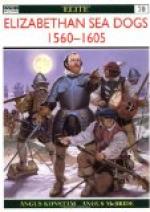The voyage was now ‘made’ in the old sense of that term; for this prize was ‘the greatest ship in all Portugal, richly laden, to our Happy Joy.’ The relative values, then and now, are impossible to fix, because not only was one dollar the equivalent in most ways of ten dollars now but, in view of the smaller material scale on which men’s lives were lived, these ten dollars might themselves be multiplied by ten, or more, without producing the same effect as the multiplied sum would now produce on international affairs. Suffice it to say that the ship was worth nearly five million dollars of actual cash, and ten, twenty, thirty, or many more millions if present sums of money are to be considered relatively to the national incomes of those poorer days.
But better than spices, jewels, and gold were the secret documents which revealed the dazzling profits of the new East-India trade by sea. From that time on for the next twelve years the London merchants and their friends at court worked steadily for official sanction in this most promising direction. At last, on the 31st of December, 1600, the documents captured by Drake produced their result, and the East-India Company, by far the greatest corporation of its kind the world has ever seen, was granted a royal charter for exclusive trade. Drake may therefore be said not only to have set the course for the United States but to have actually discovered the route leading to the Empire of India, now peopled by three hundred million subjects of the British Crown.
So ended the famous campaign of 1587, popularly known as the singeing of King Philip’s beard. Beyond a doubt it was the most consummate work of naval strategy which, up to that time, all history records.
CHAPTER IX
DRAKE AND THE SPANISH ARMADA
With 1588 the final crisis came. Philip—haughty, gloomy, and ambitious Philip, unskilled in arms, but persistent in his plans—sat in his palace at Madrid like a spider forever spinning webs that enemies tore down. Drake and the English had thrown the whole scheme of the Armada’s mobilization completely out of gear. Philip’s well-intentioned orders and counter-orders had made confusion worse confounded; and though the Spanish empire held half the riches of the world it felt the lack of ready money because English sea power had made it all parts and no whole for several months together. Then, when mobilization was resumed, Philip found himself distracted by expert advice from Santa Cruz, his admiral, and from Parma, Alva’s successor in the Netherlands.




